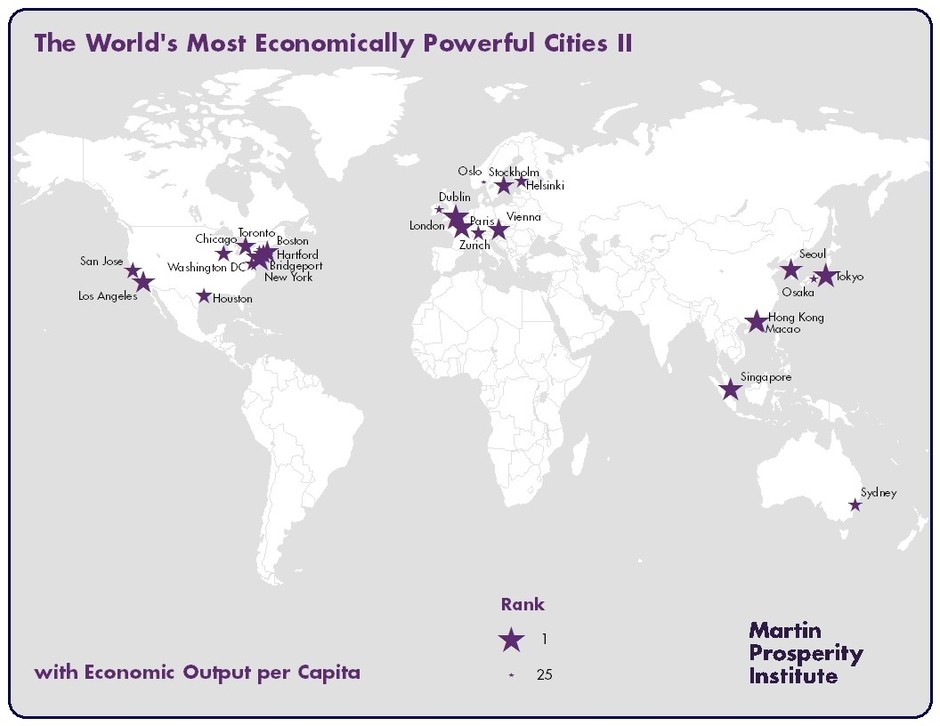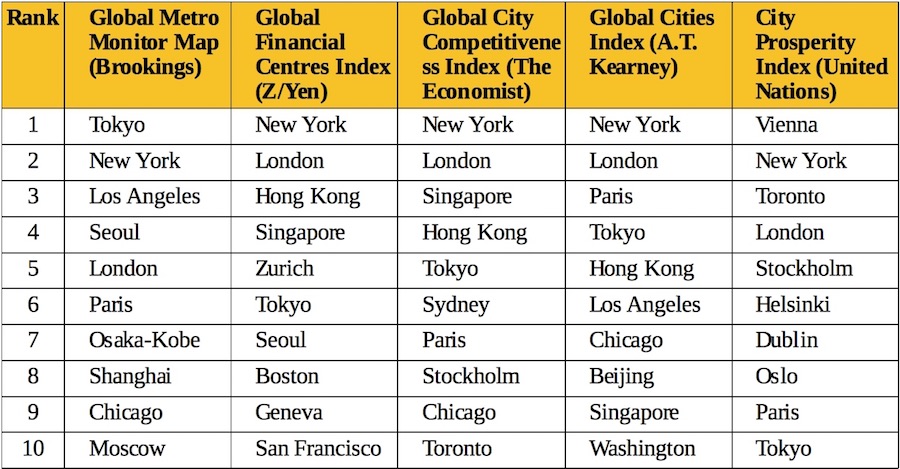
New York and London are both powerhouse cities, competitive in everything from fashion, music, and finance, to now even start-ups and high tech. In recent years, the long debate over which is the world’s most economically powerful city has reached something of a fever pitch. In 2012, London Mayor Boris Johnson (who was born in New York City and is, for now, still a dual citizen) debated members of the Bloomberg administration on this score. And earlier this month in London, Harvard economist and native New Yorker Edward Glaeser suggested his hometown is fast losing its status to London. Indeed, London should be congratulated for its remarkable run over the past couple of decades, even as the U.K.’s economy has sputtered.
But the newest ranking of the world’s most economically powerful cities put together by my Martin Prosperity Institute (MPI) research team finds New York to be the clear winner.
Our updated version of the Global City Economic Power Index (we introduced the original version in 2012) is based on five core metrics:
- Overall Economic Clout: We evaluate overall economic activity by gross domestic product (GDP) as measured by the Brookings Institution in their Global Metro Monitor Map.
- Financial Power: We gauge global financial power based on think tank and consultancy Z/Yen’s Global Financial Centres Index, which gauges the strength of a city’s finance and banking industries.
- Global Competitiveness: Here we use two measures. The Global City Competitiveness Index [PDF], by The Economist, includes 32 indicators of economic strength, physical capital, financial maturity, institutional character, human capital, global appeal, social and cultural character and environment and natural hazards. The Global Cities Index from consulting firm A.T. Kearney tracks business activity, human capital, information exchange, cultural experience, and political engagement in metros.
- Equity and Quality of Life: Lastly, we include a measure of equity and quality of life, The United Nations’ City Prosperity Index [PDF], which measures prosperity along five dimensions: productivity, infrastructure, quality of life, equity and social inclusion and environmental sustainability.
We calculate a city’s total score across these five indices, with 10 points awarded to a first place ranking, nine to a second place rank and so on.
The chart below lists the top 10 global cities on each of these five metrics alone:
From our partners:
Which takes us to our ranking. The map below charts the world’s 25 most economically powerful cities on our combined Global City Economic Power Index.

The table below provides the actual ranking scores for the top 25 global cities. (It also compares the updated 2015 rankings to their previous 2012 rank).
New York takes the top spot, with an overall score of 48, ranking first on three measures and second on the other two. London is a reasonably close second, with 40 points, based on three second-place finishes, along with a fourth and a fifth. Tokyo, which has the world’s largest metro economy, is third with 29 points. These three remain in the same spots as they did in 2012.
Hong Kong is fourth with 21 points, narrowly besting Paris (which it tied in 2012), which has 19. Singapore, Los Angeles, Seoul, Vienna, Stockholm, and Toronto round out the top ten.
The remainder of the top 25 include four U.S. cities, Chicago, Boston, D.C. and San Francisco; six European cities, Zurich, Helsinki, Dublin, Oslo, Geneva and Moscow; and four Asian cities, Sydney, Osaka-Kobe, Beijing, and Shanghai.

The next map (above) and the table (below) add an additional measure into the mix. To better control for the sheer size of metro size, we add a sixth measure, of economic output (or GDP) per capita.
New York again tops this list with a total score of 49, compared to 40 for London.
Here, Macao and Boston leap up the list. Hartford, Connecticut, another new entrant, moves to become tied for 12th. San Jose, in the heart of Silicon Valley, is tied for 15th; Houston is 17th; and Bridgeport, Connecticut, is tied for 19th.
Interestingly, for all the talk of their rapid growth and huge populations and economic size, the Chinese metros of Shanghai and Beijing fall off this list, as do Geneva, San Francisco, and Moscow.
So there you have it. New York tops London on both versions of our Global City Economic Power Index. New York’s metro economy is much larger than London’s, with total economic output of $1.4 trillion compared to $836 billion for London. New York gains additional advantage from being part of the Boston-Washington mega-region, a $3.75 trillion dollar economy. That would make it the world’s the fourth-largest economy, larger than Germany and a trillion dollars larger than $2.55 economy of the entire United Kingdom.
NYC’s advantage is likely to grow in the future. With its five boroughs, extensive transit system and metro footprint, there is plenty of room to grow beyond Manhattan (and even Brooklyn) into the outer boroughs and across into New Jersey, where housing is much more affordable than in Manhattan proper (not to mention London). And New York is a part of America’s rebounding economy, which is likely to grow far faster than Europe in the foreseeable future.
No matter whether it’s New York or London you’re rooting for, the world remains extremely spiky, with its economic gravitational pull increasingly rotating around a relatively small number of uber-powerful cities and metro areas.
This feature originally appeared in CityLab.


















